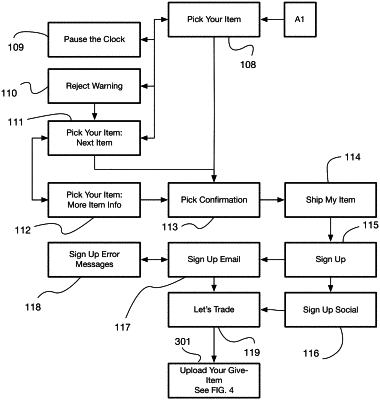| CPC G06Q 30/0601 (2013.01) [G06F 3/0481 (2013.01); G06Q 30/0641 (2013.01)] | 21 Claims |

|
1. A networked computer system that interfaces to a plurality of user computer systems, at least some of which are located remote from the networked computer system, the networked computer system comprising:
a user interface server that generates a first graphical user interface and a second graphical user interface and sends data representing the first graphical user interface and the second graphical user interface to a device client to be operated by a user of the device client in a game session, wherein the first graphical user interface is adapted to receive a user give-item commitment from the user, wherein the user give-item commitment represents a commitment from the user to give away, to a second user, a user give-item in exchange for a get-item of a plurality of get-items, wherein the user give-item is an item, product, service, or right owned by the user and wherein the get-item is an item, product, service, or right not owned by the user but desired by the user, and wherein the second graphical user interface is adapted to present, as part of the game session, a sequence of images of get-items of the plurality of get-items in sequence and adapted to present the user with indications of allowed user actions;
data storage for a user database and an items database, the items database comprising records of get-items and give-items, the records including data fields for an exchange credit value for each get-item and each give-item, wherein the items database is stored on a cloud server and includes a locking mechanism for items based on locks and releases;
an item data cache, maintained by the device client, for storing at least some items of the items database;
an item selection module of the networked computer system, coupled to the items data cache and to the user interface server to allow for access to cached items from the items database, that selects a sequence of get-items to be presented to the user as part of the game session based on a give-item exchange credit value of the user give-item and get-item exchange credit values of get-items in the items database;
a user presentation module, coupled to the user interface server, that provides the user interface server with item presentation data for game session and receives indications, from the user interface server, of user interactions with the second graphical user interface, and wherein the item presentation data depends on the user interactions with the second graphical user interface in that the user is presented with a current get-item and if the user selects, using the second graphical user interface, the current get-item during a current selection period, the current get-item is flagged as a taken get-item and if the user does not select the current get-item during the current selection period or declines the current get-item, the current get-item becomes a past get-item and a next get-item in the sequence of get-items becomes the current get-item for user selection, the user presentation module controlling which options are available for selection by the user in the game session, wherein the user presentation module prevents selection of past get-items for selection by the user unless the sequence of get-items to be presented is modified by a modification process according to a set of rules or constraints for the game session, and releases a locked state of past get-items stored in the item database on the cloud server;
a clock module, accessible by the user presentation module, for providing timing constraints on when the user interactions can occur, including a constraint that ensures that the user selects a get-item within a predetermined period or, if the user does not select a get-item within the predetermined period, ensures that the user is assigned a get-item within the predetermined period; and
an image management module, coupled to the user presentation module and the items database for serving one or more images of the current get-item.
|